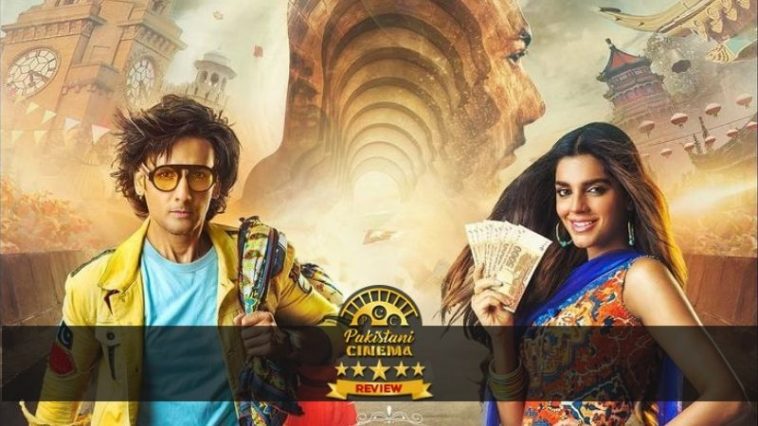Let’s cut straight to the chase. How does one summarize the essence of the recently released Pakistani film ‘Ishrat: Made in China’ in a single phrase? Admittedly that is not an easy job, for the movie is unlike any other, local or foreign, you might have seen. The closest description I can come up with, that approximates the actual viewing experience is that the film is an acid (or naswaar, if you prefer) driven trip to an alternate universe where Pakistan, the far-east, and pulp Kung-Fu vendettas have amalgamated into a singular hybrid entity. There’s enough desi masala here that you can almost smell the supari and Rooh Afza, however, the movie features all the trademark tropes of popular martial arts sagas all the same.
Is that really a good thing? You would ask. Taking a comic character out of a once-popular sitcom and placing it within such an experimental realm would be a risky bet by a mile. Then again, juxtaposing this on to the song-and-dance format would further tilt the odds against it. ‘Ishrat’ would not have looked like a ‘safe’ commercial project on paper, and working on it must have required a leap of faith on part of Mohib Mirza, who plays the titular character of Ishrat and also handles the directorial responsibility. In the end, the fruit of all the labor and toiling is a film that is visually pleasing and rather enjoyable, in parts. Given the unusual and innovative nature of the script, there were bound to be hits and misses; thankfully for us the former overshadow the latter for majority of the film’s running time.
As mentioned previously, the film exists in its own universe, where the usual laws of physics don’t apply (resulting in some fantastically watchable action sequences and chases) and which is populated by somewhat eccentric and quirky characters. There’s Ishrat, the son of a revered Hakeem, who is always being hectored at home by his mother (who we never see) and who is in love with Akhtar (Sanam Saeed). Our otherwise loitering hero ends up on a trip to China, where he encounters the film’s supervillain (HSY). Along the ride, thrown in for a good measure are some inventive gags and unexpected plot scenarios. I mean, who knew it could be so much fun watching racing chariots driven by a certain unnamed equine? I would even dare to say (to the horror of some) that the races featured in classics like Ben-Hur pale in comparison. And I truly mean that – some elements of the film’s screenplay end up being endearing in a tongue-in-cheek way.
That’s not saying it’s all a smooth ride. While ‘Ishrat’ does not quite suffer from the curse of the second half, it could have benefitted from a much tighter edit – especially in the bumpy post-interval portions, where many sequences, such as those between Ishrat and the Kung-Fu master, are dialogue-heavy and do little to further the story. Providing the many characters introduced in this part with some background and depth would have helped too. That being said, ‘Ishrat: Made in China’, for the most part, is able to conceal its thin plotline with interesting comic gags and well-choreographed action sequences and chases.
The film is also helped by some aptly quirky –and fun to watch– performances from its leads Mohib Mirza and Sanam Saeed. While Mirza’s Ishrat features slight shades of Jim Carrey’s The Mask, it is to the actor’s credit to make the character come alive in a wholly original manner on screen that you barely remember that. His female counterpart, Sanam Saeed playing Akhtar is sass and spunk personified. She looks completely at ease as she serenades the camera. Among the supporting performances, Sara Loren pitches in a surprise, being featured in a never seen before avatar. HSY as the film’s super-baddie also puts in an earnest effort which by and large works. His character could have benefitted from more CGI wizardry though, to enhance its menacing impact.
As was apparent from the film’s promos and therefore coming as no surprise are its excellent production values. A lot of credit for that goes to the competent photography by DOP Rana Kamran and his team. Whether it is an intense action sequence in the desert or a picturesque shot by the waterfall, Kamran captures the frames exceedingly well. Another department where the film shines is its styling and wardrobe, where small character details and nuances have been incorporated. The characters featured look their part and there’s a visible effort to give their styling and apparel a cinematic flavor, a quality missing from many projects that make it to the big screen.
As I was walking out of the theater, I was reminded of having chow-mein at a desi joint. Connoisseurs of authentic Chinese cuisine might gasp in horror at the thought of ordering that fare, however, for most of us it appeals to the palate even if it is nothing like what it’s supposed to be. That, in a way, is ‘Ishrat: Made in China,’ with some bland-ish portions and that occasional chili explosion added.



Comments
Loading…
Comments
0 comments